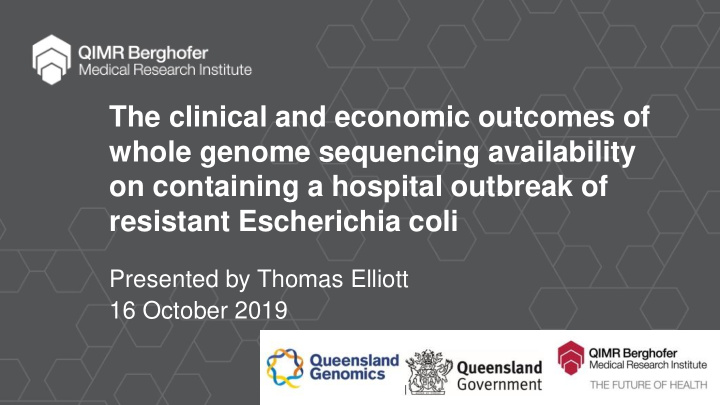



The clinical and economic outcomes of whole genome sequencing availability on containing a hospital outbreak of resistant Escherichia coli Presented by Thomas Elliott 16 October 2019
Acknowledgments PA Hospital Infection Control Team Other Collaborators QIMR Berghofer Patrick Harris, Microbiologist Prof Deborah S. Schofield Dr Louisa Gordon, A. Prof Joel Douglas, Chief Scientist Prof David L. Paterson Astrid Rodriguez-Acevedo, SRO Catherine Watson, Clinical Nurse AusHSI Consultant Xing Lee, SRO Belinda Henderson, Clinical Nurse Prof Nicholas Graves, Consultant
Healthcare-associated infections • Carbapenemase-producing Enterobacteriaceae (CPE) – antibiotic resistance makes it difficult to treat – mortality estimates of 44-70% • Aim of infection control: – identify pathogens and their antimicrobial susceptibility – reduce transmission • Current microbiology methods: – Culture swab (takes one or two days) – Pulsed-field gel electrophoresis and multi-locus sequence typing.
Why do we need bacterial whole genome sequencing (WGS)? MLPA WGS Multiplex Ligation-dependent Probe Amplification
Index case – OXA-181 outbreak No pathogen of interest 30+ days Isolation
Project aim What are the costs and effects of – Actual WGS use (what actually happened) – Earlier WGS use (what could have happened) – No WGS use (what usually happens elsewhere) to guide hospital management of the OXA-181 outbreak? Hospital cost perspective
Modelling was essential We can’t plan an outbreak (must be retrospective) We can’t do an RCT (unethical, not feasible in clinic) Stepped wedge design? (sites introducing WGS, act as own controls)
Analytic approach Hybrid Model – discrete event simulation • Hospital ward design • Doctor, nurse and patient ward movement • Infection control procedures – agent based model • The agent behaviour is described by rules that determine how these entities learn, adapt and interact with each other • Health care worker behaviour • Spatial location – Geographical Information System • incorporating hospital environment/space
Queensland Hospital Admitted Patient Data Collection - Research Variables a) Socio-economic variables Y/N flag for patients which were colonised with Oxa-181 b) Episode of care variables: - Admission date Extracted data on: - Separation date • 4,250 admissions - 1 April 2017 - Length of stay in days and 1 August 2017 - Admission ward code - Ward and unit transfer dates and times • 559 patients who were already in c) Other information: the hospital on 1 April 2017 - Planned same day (Y/N)
Queensland Hospital Admitted Patient Data Collection - Parameters Initial ward locations & Ward transfers Ward transfer pairing ward stay, – estimated empirically from from to Number proportion days (SD) the QHAPDC data set BANK discharged 126 0.82 22.6 (25.8) Ward length of stay BANK other 24 0.16 3.7 (3.9) – estimated as independent Gamma distributions for all BANK W2D 3 0.02 2.3 (0.6) observed ward pair BUNY discharged 101 0.83 25.8 (29.1) combinations using the methods of moments BUNY other 17 0.14 7.9 (15.3) BUNY W2C 4 0.03 17.5 (29)
11 Infectious disease variables Transmission Prob. = formula: # colonised = Binomial(Prob, #Susc) Level Day Day Day 69 83 111 Level 5 6 11 25 Level 2 1 3 13 GARU 1 1 14 SIU 1 4 8 Total 9 19 72
12 Cost breakdowns • • WGS cost - $356 Bedroom cleaning cost - $70 – – Sample preparation, $15 Hospital cleaning staff labour hourly rate, $31 – Sequencing, $105 – Curtains, $33 – Analysis/storage, $18 – Consumables, $5 – Scientist, $103 • Executive infection control – Isolate handling, $5 meeting - $462.03 – Labour admin, $33 – 3 senior consultants, $215 – Bioinformatics, $76 – Infection control nurse, $59 • Microbiology test cost - $80 – Senior administrator, $65 • Infection control nurse – $40/hr – Manager, $46 • Bed closure - $216
13 The model
14 The model
15 Analyses Scenarios tested – No WGS Most Hospitals • Outbreak identified in 7-15 detections • Deliberation of outbreak data 2-5 days – WGS (late) Real-life Scenario • Outbreak identified at 5 detections • WGS returned in 7 days – WGS (early) Ideal Scenario • Outbreak identified at 1 st detection • WGS returned in 7 days
16 Results – OXA-181 Total number of: No WGS WGS (late) Early WGS Colonized patients (SD) 352 (170) 197 3 (0) Detected patients (SD) 152 (75) 75 1 (0) WGS tests (SD) 79 2 (0) Bed closures (SD) 902 (486) 419 11 (2) Total costs $AU (SD) 766,921 (338,351) 460,137 (12,138) 65,374 (4,556)
17 Total cost components $1,400,000 $1,200,000 Whole Genome Seq. costs $1,000,000 Infection Control $800,000 Executive Meetings $600,000 Microbiology test costs $400,000 Cleaning costs $200,000 Nursing costs $0 Bed Closure costs Cost of bed closure increased to $800
Conclusions The use of WGS – dramatically reduced the number of colonised patients; – reduced the time till outbreak; and – Reduced the cost of stopping the outbreak Next steps? – Evaluate the use of WGS to avoid isolating patients – Evaluate the use of WGS over multiple outbreaks
Thank you www.qimrberghofer.edu.au
20 Results – Environmental contamination
21 Results – virulent scenario
Recommend
More recommend